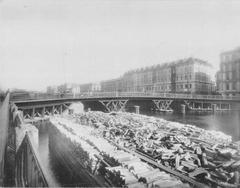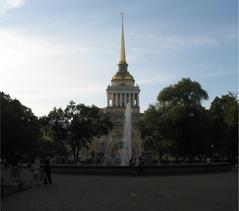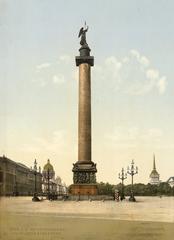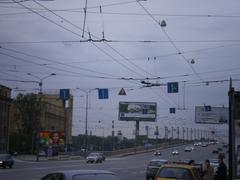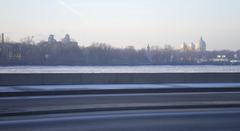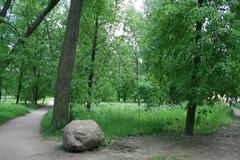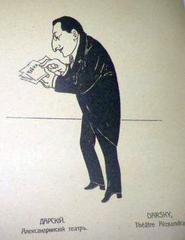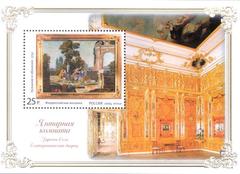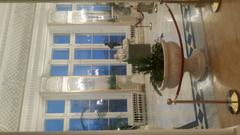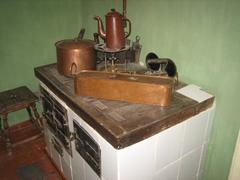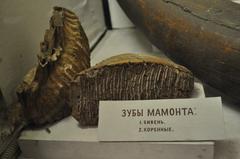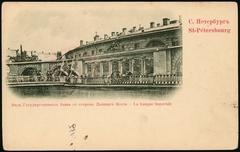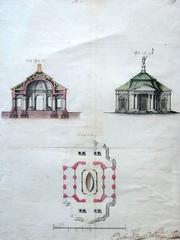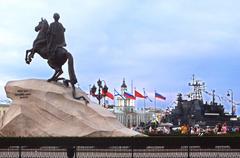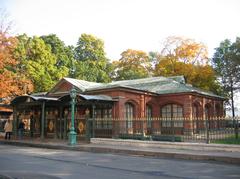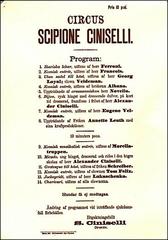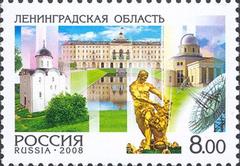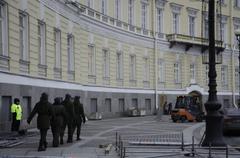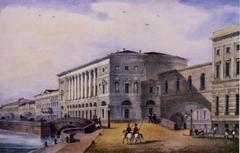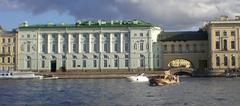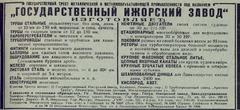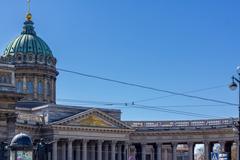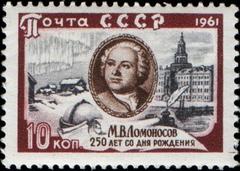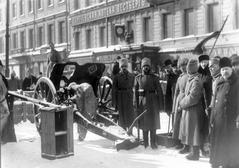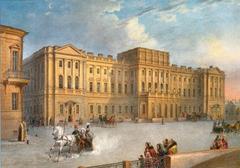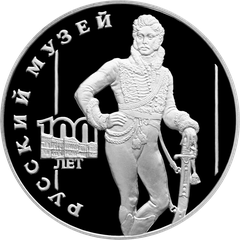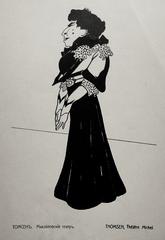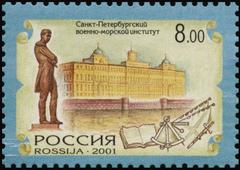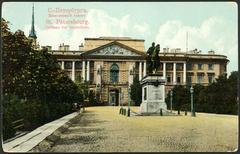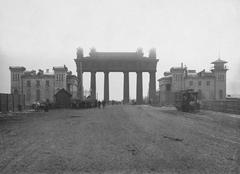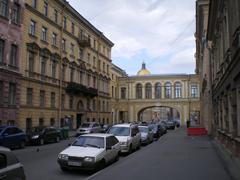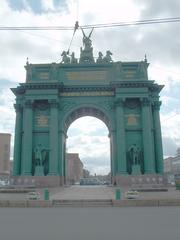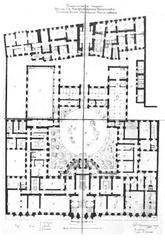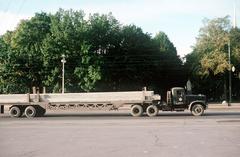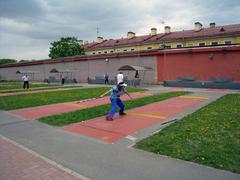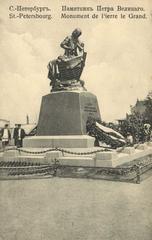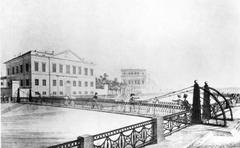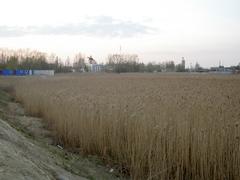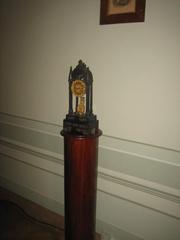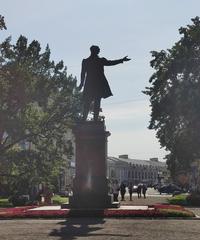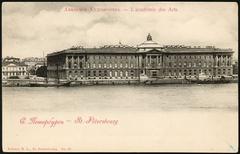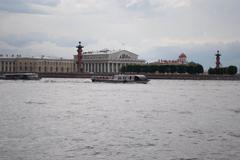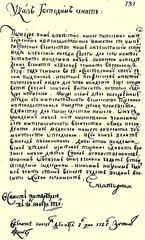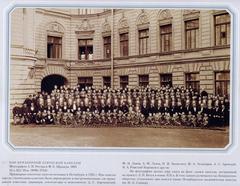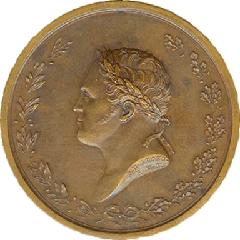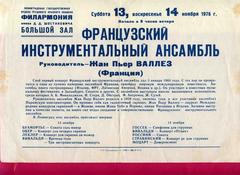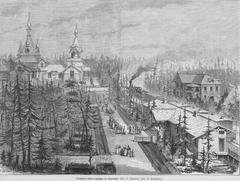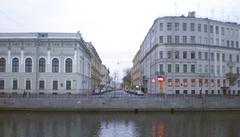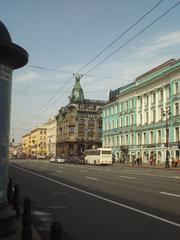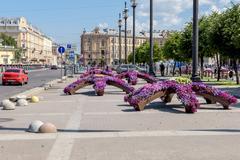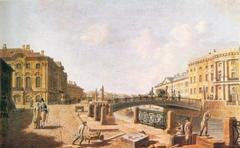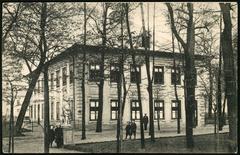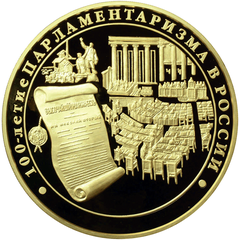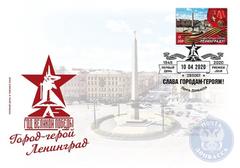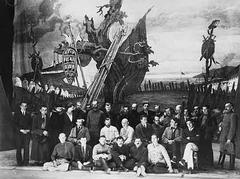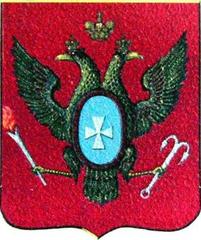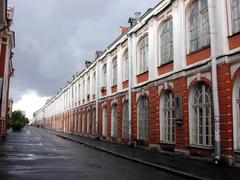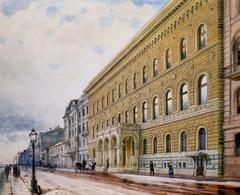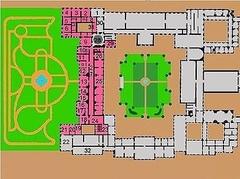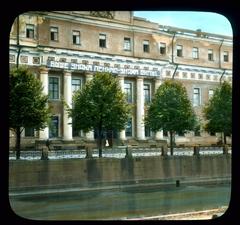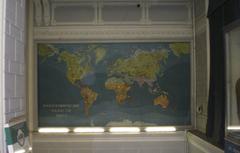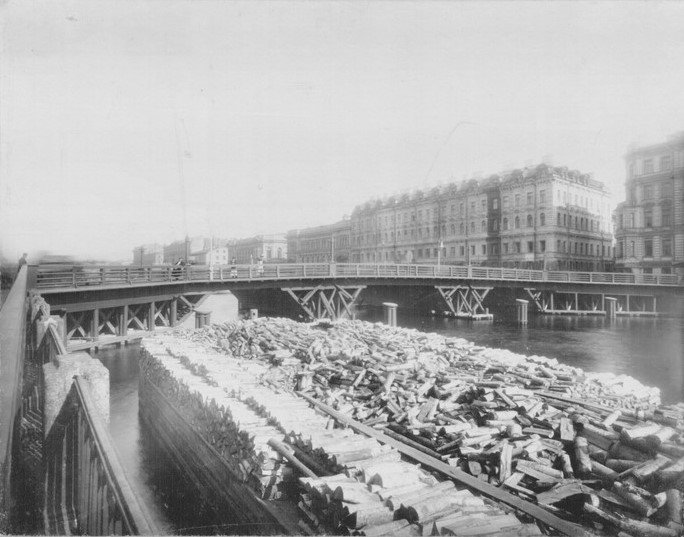
Comprehensive Guide to Visiting Leshtukov Bridge, Saint Petersburg, Russia
Date: 01/08/2024
Introduction
Leshtukov Bridge, a picturesque and historically significant structure in Saint Petersburg, Russia, spans the Fontanka River and connects the two banks in the alignment of Jambula Pereulok. Named after the court physician Lestocq of Empress Elizaveta Petrovna, this bridge stands as a testament to the city’s rich architectural and cultural heritage. Initially developed in the 18th century, the area around the Fontanka River has seen significant transformations, culminating in the construction of the metal single-span Leshtukov Bridge in 1952, replacing the earlier wooden version built in 1907 (Mostotrest; Saint-Petersburg.com).
Designed by architects L.M. Sobolev, N.S. Lebedeva, and A.Y. Sholokhov, the bridge features a length of 52.2 meters and a width of 14.2 meters, accommodating both vehicular and pedestrian traffic. Its strategic location near the Bolshoi Drama Theater underscores its cultural significance. The bridge’s proximity to this iconic theater has entrenched it in local folklore, with the phrase “Any spare tickets?” highlighting its role in the city’s vibrant cultural life (Mostotrest).
From its inception to its major repairs and reconstruction from 1993 to 1999, Leshtukov Bridge has evolved to meet modern demands while retaining its historical charm. This comprehensive guide aims to provide visitors with a detailed understanding of the bridge’s history, architectural evolution, cultural importance, and practical information for visiting this landmark. Whether one is a history enthusiast, architecture lover, or casual tourist, Leshtukov Bridge offers a unique glimpse into the heart of Saint Petersburg’s past and present.
Table of Contents
- [Exploring Leshtukov Bridge: History, Cultural Significance, and Visitor Tips](#exploring-leshtukov-bridge-history-cultural-significance-and-visitor-tipsexploring-leshtukov-bridge-history-cultural-significance-and-visitor-tips)
- [Early Beginnings and Initial Construction](#early-beginnings-and-initial-constructionearly-beginnings-and-initial-construction)
- [Architectural Evolution](#architectural-evolutionarchitectural-evolution)
- [Major Repairs and Reconstruction](#major-repairs-and-reconstructionmajor-repairs-and-reconstruction)
- [Cultural Significance](#cultural-significancecultural-significance)
- [Modern-Day Relevance](#modern-day-relevancemodern-day-relevance)
- [Visitor Information](#visitor-informationvisitor-information)
- [Nearby Attractions](#nearby-attractionsnearby-attractions)
- [Historical Context of Saint Petersburg’s Bridges](#historical-context-of-saint-petersburgs-bridgeshistorical-context-of-saint-petersburgs-bridges)
- [Viewing and Experiencing the Bridge](#viewing-and-experiencing-the-bridgeviewing-and-experiencing-the-bridge)
- [FAQ](#faqfaq)
- [Conclusion](#conclusionconclusion)
- [References](#referencesreferences)
Exploring Leshtukov Bridge: History, Cultural Significance, and Visitor Tips
Early Beginnings and Initial Construction
Leshtukov Bridge, spanning the Fontanka River in Saint Petersburg, has a rich history dating back to the early 20th century. The bridge is named after the court physician Lestocq of Empress Elizaveta Petrovna, who owned several land parcels along the Fontanka River. The area where the bridge now stands was initially developed in the 18th century when the banks of the Fontanka River were being fortified (Mostotrest).
In 1907, during the reconstruction of the nearby Chernyshev Bridge, a temporary wooden bridge was constructed at the site of the current Leshtukov Bridge. This wooden structure served the area until 1952, when it was replaced by a more durable metal single-span bridge resting on stone abutments (Saint-Petersburg.com).
Architectural Evolution
The initial wooden bridge was a simple structure, but the need for a more permanent solution led to the construction of the metal bridge in 1952. This new bridge was designed by architects L.M. Sobolev, N.S. Lebedeva, and A.Y. Sholokhov. The metal bridge, with a length of 52.2 meters and a width of 14.2 meters, was built to accommodate both vehicular and pedestrian traffic (Mostotrest).
Major Repairs and Reconstruction
From 1993 to 1999, Leshtukov Bridge underwent significant repairs and reconstruction. The project, initially conceived in 1988 by leading engineer L.N. Sobolev of the State Unitary Enterprise Legiproinzhproekt, aimed to modernize the bridge and improve its capacity to handle the heavy traffic between the banks of the Fontanka River. The full reconstruction was completed in 1999, allowing the bridge to reopen for vehicular traffic (Mostotrest).
Cultural Significance
Leshtukov Bridge holds a special place in the cultural fabric of Saint Petersburg. It leads directly to the main entrance of the Bolshoi Drama Theater, formerly the Maly Imperial Theater, which opened in 1878. The proximity of the bridge to this iconic theater has made it a popular spot for theatergoers. In fact, there is a phrase in St. Petersburg folklore associated with Leshtukov Bridge: “Any spare tickets?” This phrase reflects the bridge’s connection to the theater and its role in the city’s cultural life (Mostotrest).
Modern-Day Relevance
Today, Leshtukov Bridge continues to serve as a vital link across the Fontanka River, facilitating the movement of both vehicles and pedestrians. Its strategic location and historical significance make it an important landmark in Saint Petersburg. The bridge’s design and construction have stood the test of time, reflecting the city’s architectural heritage and engineering prowess (Structurae).
Visitor Information
Visiting Hours: Leshtukov Bridge is open 24/7, allowing visitors to explore it at any time of day.
Tickets: There is no fee to cross the bridge or to explore its surroundings.
Travel Tips: The bridge is easily accessible by public transport, with several bus and tram stops nearby. Walking is also a pleasant option, especially when combined with a visit to the nearby attractions.
Accessibility: The bridge is accessible to pedestrians and vehicles, with ramps available for wheelchair users.
Nearby Attractions
Visitors to Leshtukov Bridge can also explore several nearby attractions. The Tovstonogov Russian State Academic Bolshoi Drama Theatre, located just across the bridge, is a must-visit for theater enthusiasts. Additionally, the area around the bridge offers various accommodation options, including the Asteria Hotel, Cameo Hotel, and Fifth Corner Hotel, providing convenient lodging for tourists (Saint-Petersburg.com).
Historical Context of Saint Petersburg’s Bridges
The history of Leshtukov Bridge is intertwined with the broader history of Saint Petersburg’s bridges. The city, founded by Peter the Great in 1703, initially had very few bridges. Peter the Great encouraged the use of boats for navigation, and bridges were considered obstacles to the construction of the Russian fleet. It was only after his death that the city began to see the construction of more permanent bridges to improve transportation between the riverbanks (Culture Trip).
The first permanent drawbridge in Saint Petersburg was Blagoveshchensky Bridge, built in the mid-19th century. This was followed by the construction of other significant bridges, such as the Liteyny Bridge, which was built at the deepest point of the Neva River. The evolution of bridge construction in Saint Petersburg reflects the city’s growth and the increasing need for efficient transportation infrastructure (RBTH).
Viewing and Experiencing the Bridge
For those looking to experience Leshtukov Bridge and its surroundings, there are several options. The bridge itself offers a picturesque view of the Fontanka River and the historic buildings along its banks. Visitors can also enjoy a leisurely walk across the bridge, taking in the architectural details and the scenic beauty of the area.
Additionally, the bridge is a great starting point for exploring the nearby attractions. The Bolshoi Drama Theater offers a rich cultural experience, while the various hotels and dining options in the vicinity provide ample opportunities for relaxation and enjoyment. For a unique perspective, visitors can also consider taking a boat tour along the Fontanka River, offering a different vantage point of the bridge and the surrounding landmarks (Saint-Petersburg.com).
FAQ
What are the visiting hours for Leshtukov Bridge?
Leshtukov Bridge is open 24/7.
Are there guided tours available for Leshtukov Bridge?
While there are no specific guided tours for the bridge itself, local tour companies often include it as part of broader city or river tours.
Is there an entrance fee to visit Leshtukov Bridge?
No, there is no entrance fee to visit the bridge.
What are some nearby attractions?
The Tovstonogov Russian State Academic Bolshoi Drama Theatre is nearby, along with various hotels and dining options.
Conclusion
Leshtukov Bridge stands not only as a functional piece of infrastructure but also as a cultural and historical landmark deeply embedded in the fabric of Saint Petersburg. Its architectural evolution from a temporary wooden structure to a durable metal bridge reflects the city’s growth and modernization efforts. The bridge’s proximity to significant cultural institutions like the Bolshoi Drama Theater highlights its importance in the daily life and cultural landscape of the city.
For visitors, Leshtukov Bridge offers more than just scenic views of the Fontanka River; it provides a tangible connection to the past and a gateway to exploring Saint Petersburg’s rich heritage. With its 24/7 accessibility, no entrance fee, and nearby attractions such as the Hermitage Museum and Nevsky Prospekt, the bridge serves as an ideal starting point for both historical and cultural exploration (Structurae; Saint-Petersburg.com).
Whether you’re taking a leisurely stroll, capturing the picturesque surroundings through photography, or delving into the historical context of Saint Petersburg’s bridges, Leshtukov Bridge promises a memorable experience. It encapsulates the essence of the city’s architectural prowess and cultural richness, making it a must-visit for anyone traveling to Saint Petersburg. As you plan your visit, remember to explore the nearby attractions, enjoy the local cuisine, and immerse yourself in the vibrant history that surrounds this iconic bridge.
References
- Mostotrest. (n.d.). Leshtukov Bridge. Mostotrest
- Saint-Petersburg.com. (n.d.). Leshtukov Bridge. Saint-Petersburg.com
- Structurae. (n.d.). Leshtukov Bridge. Structurae
- Culture Trip. (n.d.). History Behind St. Petersburg’s Bridges. Culture Trip
- RBTH. (n.d.). Petersburg Drawbridges Work. RBTH
